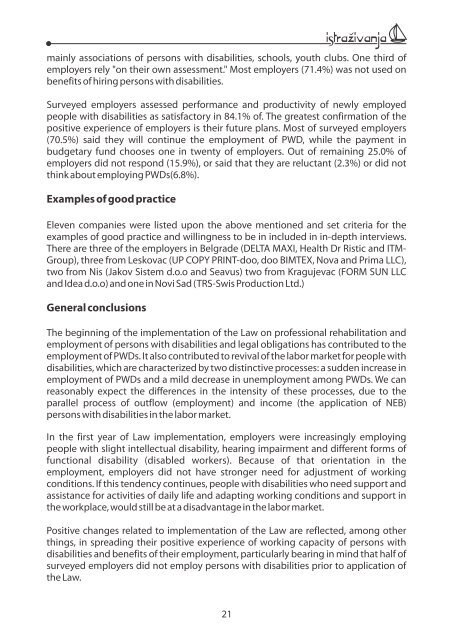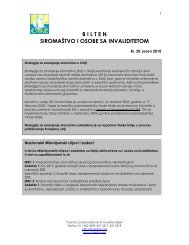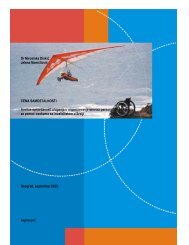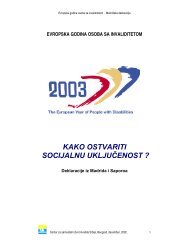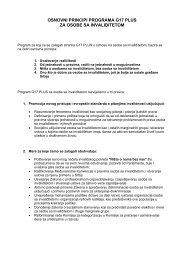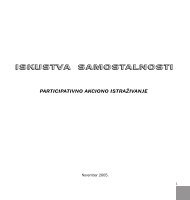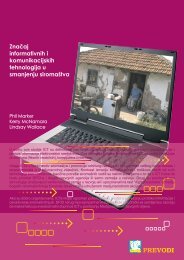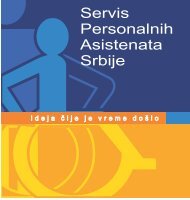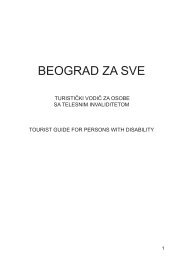OBAVEZA ZAPOŠLJAVANJA OSOBA SA INVALIDITETOM U SRBIJI Primeri dobre prakse
Preuzmite ovde - Centar za samostalni Život osoba sa invaliditetom ...
Preuzmite ovde - Centar za samostalni Život osoba sa invaliditetom ...
You also want an ePaper? Increase the reach of your titles
YUMPU automatically turns print PDFs into web optimized ePapers that Google loves.
mainly associations of persons with disabilities, schools, youth clubs. One third of<br />
employers rely "on their own assessment." Most employers (71.4%) was not used on<br />
benefits of hiring persons with disabilities.<br />
Surveyed employers assessed performance and productivity of newly employed<br />
people with disabilities as satisfactory in 84.1% of. The greatest confirmation of the<br />
positive experience of employers is their future plans. Most of surveyed employers<br />
(70.5%) said they will continue the employment of PWD, while the payment in<br />
budgetary fund chooses one in twenty of employers. Out of remaining 25.0% of<br />
employers did not respond (15.9%), or said that they are reluctant (2.3%) or did not<br />
think about employing PWDs(6.8%).<br />
Examples of good practice<br />
Eleven companies were listed upon the above mentioned and set criteria for the<br />
examples of good practice and willingness to be in included in in-depth interviews.<br />
There are three of the employers in Belgrade (DELTA MAXI, Health Dr Ristic and ITM-<br />
Group), three from Leskovac (UP COPY PRINT-doo, doo BIMTEX, Nova and Prima LLC),<br />
two from Nis (Jakov Sistem d.o.o and Seavus) two from Kragujevac (FORM SUN LLC<br />
and Idea d.o.o) and one in Novi Sad (TRS-Swis Production Ltd.)<br />
General conclusions<br />
istrazivanja<br />
The beginning of the implementation of the Law on professional rehabilitation and<br />
employment of persons with disabilities and legal obligations has contributed to the<br />
employment of PWDs. It also contributed to revival of the labor market for people with<br />
disabilities, which are characterized by two distinctive processes: a sudden increase in<br />
employment of PWDs and a mild decrease in unemployment among PWDs. We can<br />
reasonably expect the differences in the intensity of these processes, due to the<br />
parallel process of outflow (employment) and income (the application of NEB)<br />
persons with disabilities in the labor market.<br />
In the first year of Law implementation, employers were increasingly employing<br />
people with slight intellectual disability, hearing impairment and different forms of<br />
functional disability (disabled workers). Because of that orientation in the<br />
employment, employers did not have stronger need for adjustment of working<br />
conditions. If this tendency continues, people with disabilities who need support and<br />
assistance for activities of daily life and adapting working conditions and support in<br />
the workplace, would still be at a disadvantage in the labor market.<br />
Positive changes related to implementation of the Law are reflected, among other<br />
things, in spreading their positive experience of working capacity of persons with<br />
disabilities and benefits of their employment, particularly bearing in mind that half of<br />
surveyed employers did not employ persons with disabilities prior to application of<br />
the Law.<br />
21


